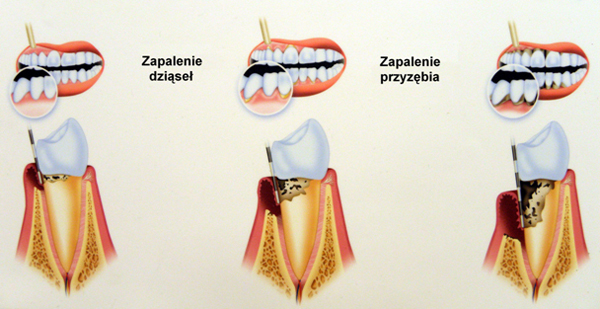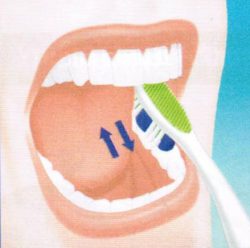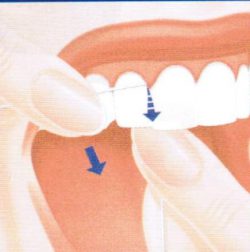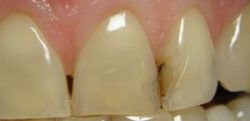Methods of cleaning and flossing teeth
Dentysta stomatolog Warszawa Ursynów ADENTIS / Information and advice / Dental advice / Methods of cleaning and flossing teeth

We can only help you. How you follow our recommendations and suggestions will allow us to take care of your healthy and beautiful smile together.
We invite you to come for check-ups every 6 months and observe oral hygiene.
At ADENTIS, each patient receives individual oral hygiene instruction.

Correct tooth brushing technique is extremely important for the effectiveness of oral hygiene. Horizontal brushing should definitely be avoided.
This way, you will gently but thoroughly remove food remains and plaque.
 |
 |
 |
We brush the side teeth from the cheek, tongue and finally the upper surface of the teeth.
Brush your teeth methodically: start with the outer surfaces, then move to the inner surfaces, and finally brush the chewing surfaces. Always start by brushing the back of your teeth as this is the hardest part to clean.
To clean the inside surfaces of the upper front teeth, position the brush vertically and place the bristles at the border of the teeth and gums. Make sweeping movements with the brush downwards from the gums to the tips of the teeth. Brush the inner surfaces of your lower teeth in the same way, but this time use upward sweeping movements.
 |
 |
We brush the front teeth from the inside, outside and finally floss.
 |
 |
Interdental brushes.
 |
 |
| Inflammation of the gums. | Stained bacterial plaque. |
 |
 |
| Bacterial plaque remaining. | Stained bacterial plaque. |
Tooth flossing

With a toothbrush we can only clean 3 out of 5 surfaces of our teeth. The remaining two (between the teeth), despite thorough brushing, remain not cleaned.
The spaces between teeth are where tooth decay usually develops. These places are difficult to access and cannot be cleaned with a brush. A lot of food remains remain in them and dental plaque accumulates, which blocks the access of oxygen, facilitating the development of anaerobic bacteria responsible for the formation of caries.
Flossing also oxygenates the contact surfaces, which destroys anaerobic bacteria.
Caries in the interdental spaces remains unnoticed for a long time, which may lead to tooth pulp diseases. After some time, root canal treatment is necessary. The filling on the proximal surface does not protect against the recurrence of caries, and secondary caries may appear under the filling. Therefore, proper dental hygiene protects against invasive dental procedures.
 |
 |
| Secondary caries under the filling | Aesthetic tooth filling |
Be sure to use dental floss to clean places where the toothbrush cannot reach. This is the only way to thoroughly clean the tight spaces between your teeth.
There are two basic types of thread:
- standard – for cleaning interdental spaces within natural teeth,
- specialized – for people with prosthetic restorations. Cleaning the spaces between teeth with dental floss
 Take out about 50 cm of dental floss – from the container, break off a measured piece, wrap it around your middle fingers and hold it firmly with your thumbs (when cleaning the upper jaw) or index fingers (when cleaning the lower jaw).
Take out about 50 cm of dental floss – from the container, break off a measured piece, wrap it around your middle fingers and hold it firmly with your thumbs (when cleaning the upper jaw) or index fingers (when cleaning the lower jaw).
 Insert the floss between your teeth with gentle movements. Form a U-shaped floss in the middle of the tooth and clean its surface with up-and-down movements. Then clean the proximal surface of the adjacent tooth in the same way.
Insert the floss between your teeth with gentle movements. Form a U-shaped floss in the middle of the tooth and clean its surface with up-and-down movements. Then clean the proximal surface of the adjacent tooth in the same way.
 After each meal, food remains remain between the teeth and if not removed, they rot and ferment, contributing to the attack of bacteria on the tooth surface, which causes demineralization of the enamel and, as a result, carious lesions in the interdental spaces.
After each meal, food remains remain between the teeth and if not removed, they rot and ferment, contributing to the attack of bacteria on the tooth surface, which causes demineralization of the enamel and, as a result, carious lesions in the interdental spaces.
Oral-B Essential Floss™ cleans places that a toothbrush cannot reach. Its specially designed fiber is covered with a polymer coating, which makes removing the plaque effortless. Oral-B EssentialFloss™ does not fray or tear. It is easy to slide into the spaces between the teeth.
Product features:
• The special structure of the fiber allows the floss to be easily inserted between the teeth
• The fibers do not fray or break – for your safety and comfort
• The floss is waxed, which makes it even easier to slide it between the teeth
• Available in mint flavor
| Caries defect on the proximal surface, caused by not flossing the teeth. |
Anirrigator is very helpful in maintaining proper hygiene – a device that helps maintain healthy teeth and gums and remove food remnants and bacteria from those spaces of the oral cavity where normal rinsing and cleaning agents cannot reach. To increase the effectiveness of the irrigator, you can use any mouthwash or antibacterial solution recommended by your dentist. The irrigator is ideal for cleaning the space around fixed appliances, crowns and bridges. It can have different tips, so it can be used by the whole family. We also recommendelectric or sonic brushes; compared to manual brushes, they are more effective in maintaining proper oral hygiene.
Dr Aleksandra Gabren
